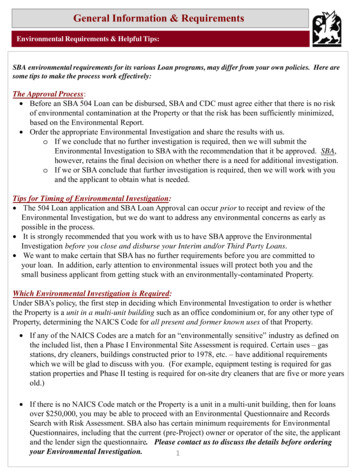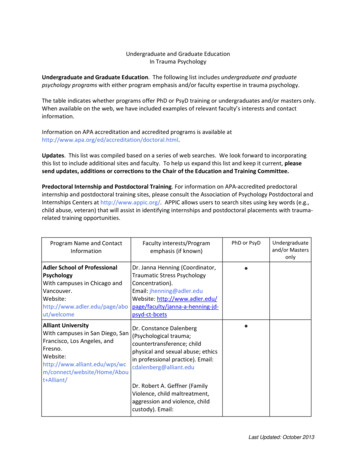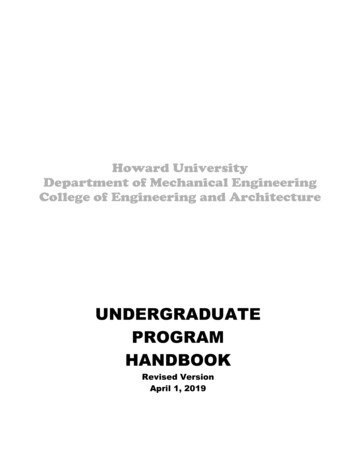
Transcription
Environmental Studies For Undergraduate CoursesErach Bharucha
CORE MODULE SYLLABUS FOR ENVIRONMENTAL STUDIESFOR UNDER GRADUATE COURSES OF ALL BRANCHESOF HIGHER EDUCATIONVisionThe importance of environmental science and environmental studies cannot bedisputed. The need for sustainable development is a key to the future of mankind.Continuing problems of pollution, loss of forget, solid waste disposal, degradation ofenvironment, issues like economic productivity and national security, Global warming,the depletion of ozone layer and loss of biodiversity have made everyone aware ofenvironmental issues. The United Nations Coference on Environment and Developmentheld in Rio de Janerio in 1992 and world Summit on Sustainable Development atJohannesburg in 2002 have drawn the attention of people around the globe to thedeteriorating condition of our environment. It is clear that no citizen of the earth canafford to be ignorant of environment issues. Environmental management has captured theattention of health care managers. Managing environmental hazards has become veryimportant.Human beings have been interested in ecology since the beginning of civilization.Even our ancient scriptures have emphasized about practices and values of environmentalconservation. It is now even more critical than ever before for mankind as a whole tohave a clear understanding of environmental concerns and to follow sustainabledevelopment practices.India is rich in biodiversity which provides various resources for people. It is alsobasis for biotechnology.Only about 1.7 million living organisms have been diescribed and namedglobally. Still manay more remain to be identified and described. Attempts are made toI
conserve them in ex-situ and in-situ situations. Intellectual property rights (IPRs) havebecome importanat in a biodiversity-rich country like India to protect microbes, plantsand animals that have useful genetic properties. Destruction of habitats, over-use ofenergy resource and environmental pollution have been found to be responsible for theloss of a large number of life-forms. It is feared that a large proportion of life on earthmay get wiped out in the near future.Inspite of the deteriorating status of the environment, study of environment haveso far not received adequate attention in our academic programmes. Recognizing this, theHon’ble Supreme Court directed the UGC to introduce a basic course on environment atevery level in college education. Accordingly, the matter was considered by UGC and itwas decided that a six months compulsory core module course in environmental studiesmay be prepared and compulsorily implemented in all the University/Colleges of India.The experts committee appointed by the UGC has looked into all the pertinentquestions, issues and other relevant matters. This was followed by framing of the coremodule syllabus for environmental studies for undergraduate courses of all branches ofHigher Education. We are deeply conscious that there are bound to be gaps between theideal and real. Geniune endeavour is required to minimize the gaps by intellectual andmaterial inputs. The success of this course will depend on the initiative and drive of theteachers and the receptive students.SYLLABUSUnit 1 : Multidisciplinary nature of environmental studiesDefinition, scope and importance(2 lectures)Need for public awareness.II
Unit 2 : Natural Resources :Renewable and non-renewable resources :Natural resources and associated problems.a)Forest resources : Use and over-exploitation, deforestation, case studies.Timber extraction, mining, dams and their effects on forest and tribal people.b)Water resources : Use and over-utilization of surface and ground water,floods, drought, conflicts over water, dams-benefits and problems.c)Mineral resources : Use and exploitation, environmental effects of extractingand using mineral resources, case studies.d)Food resources : World food problems, changes caused by agriculture andovergrazing, effects of modern agriculture, fertilizer-pesticide problems, waterlogging, salinity, case studies.e)Energy resources : Growing energy needs, renewable and non renewableenergy sources, use of alternate energy sources. Case studies.f)Land resources : Land as a resource, land degradation, man inducedlandslides, soil erosion and desertification. Role of an individual in conservation of natural resources. Equitable use of resoureces for sustainable lifestyles.(8 lectures)Unit 3 : Ecosystems Concept of an ecosystem.III
Structure and function of an ecosystem. Producers, consumers and decomposers. Energy flow in the ecosystem. Ecological succession. Food chains, food webs and ecological pyramids. Introduction, types, characteristic features, structure and function of thefollowing ecosystem :a. Forest ecosystemb. Grassland ecosystemc. Desert ecosystemd. Aquatic ecosystems (ponds, streams, lakes, rivers, oceans, estuaries)(6 lectures)Unit 4 : Biodiversity and its conservation Introduction – Definition : genetic, species and ecosystem diversity. Biogeographical classification of India Value of biodiversity : consumptive use, productive use, social, ethical, aestheticand option values Biodiversity at global, National and local levels. Inida as a mega-diversity nationIV
Hot-sports of biodiversity. Threats to biodiversity : habitat loss, poaching of wildlife, man-wildlife conflicts. Endangered and endemic species of India Conservation of biodiversity : In-situ and Ex-situ conservation of biodiversity.(8 lectures)Unit 5 : Environmental PollutionDefinition Cause, effects and control measures of :a.Air pollutionb.Water pollutionc.Soil pollutiond.Marine pollutione.Noise pollutionf.Thermal pollutiong.Nuclear hazardsSolid waste Management : Causes, effects and control measures of urban andindustrial wastes. Role of an individual in prevention of pollution. Pollution case studies. Diaster management : floods, earthquake, cyclone and landslides.(8 lectures)V
Unit 6 : Social Issues and the Environment From Unsustainable to Sustainable development Urban problems related to energy Water conservation, rain water harvesting, watershed management Resettlement and rahabilitation of people; its problems and concerns. CaseStudies Environmental ethics : Issues and possible solutions. Climate change, global warming, acid rain, ozone layer depletion, nuclearaccidents and holocaust. Case Studies. Wasteland reclamation. Consumerism and waste products. Environment Protection Act. Air (Prevention and Control of Pollution) Act. Water (Prevention and control of Pollution) Act Wildlife Protection Act Forest Conservation Act Issues involved in enforcement of environmental legislation. Public awareness.(7 lectures)Unit 7 : Human Population and the Environment Population growth, variation among nations. Population explosion – Family Welfare Programme.VI
Environment and human health. Human Rights. Value Education. HIV/AIDS. Women and Child Welfare. Role of Information Technology in Environment and human health. Case Studies.(6 lectures)Unit 8 : Field work Visit to a local area to document environmental assetsriver/forest/grassland/hill/mountain Visit to a local polluted site-Urban/Rural/Industrial/Agricultural Study of common plants, insects, birds. Study of simple ecosystems-pond, river, hill slopes, etc. (Field work Equal to 5lecture hours)VII
SIX MONTHS COMPULSORY CORE MODULE COURSE INENVIRONMENTAL STUDIES : FOR UNDERGRADUATESTeaching MethodologiesThe core Moudle Syllabus for Environment Studies includes class room teachingand Field Work. The syllabus is divided into eight units covering 50 lectures. The firstseven units will cover 45 lectures which are class room based to enhance knowledgeskills and attitute to environment. Unit eight is based on field activites which will becovered in five lecture hours and would provide student first hand knowledge on varioslocal environmental aspects. Field experience is one of the most effective learning toolsfor environmental concerns. This moves out of the scope of the text book mode ofteaching into the realm of real learning in the field, where the teacher merely acts as acatalyst to interpret what the student observes or discovers in his/her own environment.Field studies are as essential as class work and form an irreplaceable synergistic tool inthe entire learning process.Course material provided by UGC for class room teaching and field activities beutilized.The universities/colleges can also draw upon expertise of outside resource personsfor teaching purpose.Environmental Core Module shall be integrated into the teaching programmes ofall undergraduate courses.Annual System :The duration of the course will be 50 lectures. The exam will beconducted along with the Annual Examination.VIII
Semester System : The Environment course of 50 lectures will be conducted in thesecond semester and the examination shall be conducted at the end of the secondsemester.Credt System :The course will be awarded 4 credits.Exam Pattern :In case of awarding the marks, the question paper shouldcarry 100 marks. The structure of the question paper being :Part-A, Short answer pattern-25 marksPart-B, Essay type with inbuilt choice-50 marksPart-C, Field Work-25 marksIX
REFERENCEa)Agarwal, K.C. 2001 Environmental Biology, Nidi Publ. Ltd. Bikaner.b)Bharucha Erach, The Biodiversity of India, Mapin Publishing Pvt. Ltd.,Ahmedabad – 380 013, India, Email:mapin@icenet.net (R)c)Brunner R.C., 1989, Hazardous Waste Incineration, McGraw Hill Inc. 480pd)Clark R.S., Marine Pollution, Clanderson Press Oxford (TB)e)Cunningham, W.P. Cooper, T.H. Gorhani, E & Hepworth, M.T. 2001,Environmental Encyclopedia, Jaico Publ. House, Mumabai, 1196pf)De A.K., Environmental Chemistry, Wiley Eastern Ltd.g)Down to Earth, Centre for Science and Environment (R)h)Gleick, H.P. 1993. Water in crisis, Pacific Institute for Studies in Dev.,Environment & Security. Stockholm Env. Institute Oxford Univ. Press. 473pi)Hawkins R.E., Encyclopedia of Indian Natural History, Bombay NaturalHistory Society, Bombay (R)j)Heywood, V.H & Waston, R.T. 1995. Global Biodiversity Assessment.Cambridge Univ. Press 1140p.k)Jadhav, H & Bhosale, V.M. 1995. Environmental Protection and Laws.Himalaya Pub. House, Delhi 284 p.l)Mckinney, M.L. & School, R.M. 1996. Environmental Science systems &Solutions, Web enhanced edition. 639p.m)Mhaskar A.K., Matter Hazardous, Techno-Science Publication (TB)n)Miller T.G. Jr. Environmental Science, Wadsworth Publishing Co. (TB)o)Odum, E.P. 1971. Fundamentals of Ecology. W.B. Saunders Co. USA, 574pp)Rao M N. & Datta, A.K. 1987. Waste Water treatment. Oxford & IBH Publ.Co. Pvt. Ltd. 345p.q)Sharma B.K., 2001. Environmental Chemistry. Geol Publ. House, Meerutr)Survey of the Environment, The Hindu (M)s)Townsend C., Harper J, and Michael Begon, Essentials of Ecology, BlackwellScience (TB)X
t)Trivedi R.K., Handbook of Environmental Laws, Rules Guidelines,Compliances and Stadards, Vol I and II, Enviro Media (R)u)Trivedi R. K. and P.K. Goel, Introduction to air pollution, Techno-SciencePublication (TB)v)Wanger K.D., 1998 Environmental Management. W.B. Saunders Co.Philadelphia, USA 499p(M) Magazine(R) Reference(TB) TextbookXI
Mmbers of the Expert Committee on Environmental Studies1.Prof. Erach BharuchaDirectorBharati VidyapeethInstitute of Environment Education &Research, Pune2.Prof. C. ManoharacharyDepartment of BotanyOsmania UniversityHyderabad3.Prof. S. ThayumanavanDirectorCentre for Environmental StudiesAnna University, Chennai4.Prof. D.C. GoswamiHead, Deptt. Of Environment ScienceGauhati UniversityGuwahati-781 0145.Shri R. MehtaDirector EE DivisionMinistry of Environment & ForestPrayavaran Bhawan, CGO ComplexLodhi Road, New Delhi-110 003UGC OFFICIALS6.Dr. N. K. JainJoint SecretaryUGC, New DelhiXII
Textbook forEnvironmental StudiesFor Undergraduate Coursesof all Branches of Higher EducationErach BharuchaforUniversity Grants CommissionNatural ResourcesPreliminary Pages.p65i14/9/2004, 5:06 PM
CreditsPrincipal author and editor – Erach BharuchaUnit 1 – Erach BharuchaUnit 2 – Erach Bharucha, Behafrid PatelUnit 3 – Erach BharuchaUnit 4 – Erach BharuchaUnit 5 – Shamita KumarUnit 6 – Erach Bharucha, Shalini Nair, Behafrid PatelUnit 7 – Erach Bharucha, Shalini Nair, Behafrid PatelUnit 8 – Erach Bharucha, Shambhvi JoshiCase Studies – Prasanna KolteCo-ordination and compilation – Behafrid PatelTextbook Design – Narendra Kulkarni (Mudra), Sushma DurveManuscript review and editing – Chinmaya Dunster, Behafrid PatelArtists – Sushma Durve and Anagha DeshpandeCD ROM – Jaya Rai and Prasanna Kolte CopyrightText – Erach Bharucha/ UGC, 2004.Photographs – Erach BharuchaDrawings – Bharati Vidyapeeth Institute of Environment Education and ResearchAll rights reserved.Distributed byUniversity Grants Commission, New Delhi. 2004.Environmental Studies for Undergraduate CoursesiiPreliminary Pages.p6524/9/2004, 5:06 PM
VisionThe importance of Environmental Studies cannot be disputed. The need for sustainable development is a key to the future of mankind. The degradation of our environment is linked to continuingproblems of pollution, loss of forest, solid waste disposal, issues related to economic productivityand national as well as ecological security. The increasing levels of global warming, the depletion ofthe ozone layer and a serious loss of biodiversity have also made everyone aware of growing environmental concerns. The United Nations Conference on Environment and Development held in RioDe Janero in 1992, and the World Summit on Sustainable Development at Zoharbex in 2002 havedrawn the attention of people around the globe to the developing condition of our environment. Itis clear that no citizen of the earth can afford to be ignorant of environmental issues. Environmentalmanagement has become a part of the health care sector. Managing environmental hazards andpreventing possible disasters has become an urgent need.Human beings have been interested in ecology since the beginning of civilization. Even our ancientscriptures have included practices and values related with environmental conservation. It is noweven more critical than ever before for mankind as a whole to have a clear understanding ofenvironmental concerns and to follow sustainable development practices.India is rich in biodiversity which provides various resources for people. It is also the basis for biotechnological development. Only about 1.8 million living organisms have been described and namedglobally. Still many more remain to be identified and described. Attempts are made to conservethem in ex-situ and in-situ situation. Intellectual Property Rights (IPRs) have become important in abiodiversity rich country like India to protect microbes, plants and animals that have useful geneticproperties. Destruction of habitats, over use of energy resources and environmental pollution havebeen found to be responsible for the loss of a large number of life forms. It is feared that a largeproportion of life on earth may get wiped out in the near future.In spite of the developing status of the environment, the formal study of environment has so far notreceived adequate attention in our academic performances. Recognisation thus the Hon’ble Supreme Court directed the UGC to introduce a basic course on environment for every student.Accordingly the matter was considered by the UGC and it was decided that a six months compulsory core module course in environmental studies may be prepared and compulsorily implementedin all the Universities/ Colleges in India.The Expert Committee appointed by the UGC has looked into all the pertinent questions, issues andother relevant matters. This was followed by framing of the Core Module Syllabus for Environmental Studies for undergraduate courses of all branches of Higher Education. The Committee is deeplyconscious that there are bound to be gaps between what is considered ideal and the presentsyllabus. The Committee has attempted to minimize the gaps by intellectual and material inputs.The success of this course will however depend on the initiative and drive of the teachers and theirstudents.Members of the Curriculum Development CommitteeNatural ResourcesPreliminary Pages.p65iii34/9/2004, 5:06 PM
Members of the Expert Committee on Environmental Studies1. Prof. Erach BharuchaDirector,Bharati Vidyapeeth Institute of Environment Education and Research,Pune2. Prof. C ManoharacharyDepartment of Botany,Osmania University, Hyderabad3. Prof. S ThayumanavanDirectorCenter for Environmental Studies,Anna University, Chennai4. Prof. D C GoswamiHead, Department of Environment Science,Gauhati University,Guwahati – 781 0145. Shri R MehtaDirector EE DivisionMinistry of Environment and Forests,Paryavaran Bhavan, CGO Complex,Lodhi Road, New Delhi – 110 003UGC Officials6. Dr. NK JainJoint Secretary,UGC, New DelhiEnvironmental Studies for Undergraduate CoursesivPreliminary Pages.p6544/9/2004, 5:06 PM
Six Months Compulsory Core Module Coursein Environmental Studies: for Undergraduate StudentsTeaching MethodologiesThe Core Module Syllabus for Environmental Studies includes classroom teaching and fieldwork.The syllabus is divided into eight units covering 50 lectures. The first seven units which will cover 45lectures are classroom teaching based to enhance knowledge skilled and attitude to environment.Unit eight is based on field activities and would be covered over five lecture hours and wouldprovide students with first hand knowledge on various local environmental aspects. Field experience is one of the most effective learning tools for environmental concerns. This moves out of thescope of the textbook mode of teaching, into the realm of real learning in the field, where theteacher acts as a catalyst to interpret what the student observes or discovers in his/her own environment. Field studies area as essential as class work and form an irreplaceable synergistic tool in theentire learning process.The course material provided by UGC for class room teaching and field activities should be utilised.The Universities/ colleges can draw upon expertise of outside resource persons for teaching purposes.The Environmental Core Module shall be integrated into the teaching programs of all undergraduate courses.Annual System: The duration of the course will be 50 lectures. The exam will be conducted alongwith the Annual Examination.Semester System: the Environment course of 50 lectures will be conducted in the second semesterand the examinations shall be conducted at the end of the second semester.Credit System: The core course will be awarded 4 creditsExam Pattern: In case of awarding the marks the question paper should carry 100 marks. Thestructure of the question paper being:Part A, Short answer patternPart B, Essay type built choicePart C, Field Work- 25 marks- 50 marks- 25 marksNatural ResourcesPreliminary Pages.p65v54/9/2004, 5:06 PM
Further Readings1. Agarwal KC, 2001. Environmental Biology, Nidi Publishers Ltd. Bikaner.2. Bharucha Erach, 2003. The Biodiversity of India, Mapin Publishing Pvt. Ltd, Ahmedabad – 380013,India. Email: mapin@icenet.net3. Brunner RC, 1989, Hazardous Waste Incineration, McGraw Hill Inc. 480pgs.4. Clark RS, Marine Pollution, Clanderson Press, Oxofrd (TB).5. Cunningham WP, Cooper TH, Gorhani E & Hepworth MT, 2001. Environmental Encyclopaedia,Jaico Publishing House, Mumbai, 1196pgs.6. De AK, Environmental Chemistry, Wiley Eastern Ltd.7. Down to Earth, Center for Science and Environment (R)8. Gleick HP, 1993. Water in Crisis, Pacific Institute for Studies in Development, Environment andSecurity. Stockholm Environmental Institute, Oxford University Press, 473pgs.9. Hawkins RE, Encyclopedia of Indian Natural History, Bombay Natural History Society, Bombay(R)10. Heywood VH, and Watson RT, 1995. global Biodiversity Assessment. Cambridge UniversityPress 1140pgs.11. Jadhav H and Bhosale VM, 1995. Environmental Protection and Laws. Himalaya PublishingHouse, Delhi 284pgs.12. Mckinney ML and Schoch RM, 1996. Environmental Science Systems and Solutions. Web enhanced edition, 639pgs.13. Mhaskar AK, Matter Hazardous, Techno-Science Publications (TB)14. Miller TG, Jr. Environmental Science, Wadsworth Publishing CO. (TB)15. Odum EP, 1971. Fundamentals of Ecology. WB Saunders Co. USA, 574pgs.16. Rao MN and Datta AK, 1987. Waste Water Treatment. Oxford and IBH Publishing Co. Pvt. Ltd.345pgs.Environmental Studies for Undergraduate CoursesviPreliminary Pages.p6564/9/2004, 5:06 PM
IT 1: THE MULTIDISCIPLINARY NATURE OF ENVIRONMENTALSTUDIES1.1DEFINITION, SCOPE AND IMPORTANCE1.1.1 Definition1.1.2 Scope1.1.3 Importance1.2NEED FOR PUBLIC AWARENESS1.2.1 Institutions in Environment1.2.2 People in Environment33358912UNIT 2: NATURAL RESOURCES2.1 INTRODUCTION162.2 RENEWABLE AND NON-RENEWABLE RESOURCES2.2.1 Natural resources and associated problems2.2.2 Non-renewable resources2.2.3 Renewable resourcesa. Forest Resources: Use and over-exploitation, deforestation, case studies.Timber extraction, mining, dams and their effects on forests and tribal peopleb. Water Resources: Use and over-utilisation of surface and ground water,floods, drought, conflicts over water, dams – benefits and problems.c. Mineral Resources: Use and exploitation, environmental effects of extractingand using mineral resources, case studies.d. Food Resources: World food problems, Changes in landuse by agriculture andgrazing, Effects of modern agriculture, Fertilizer/ pesticide problems,Water logging and salinitye. Energy Resources: Increasing energy needs, Renewable/ non renewable,Use of Alternate energy sources, Case studiesf. Land resources: Land as a resource, land degradation, man-induced land-slides,soil erosion and desertification.2020222223Natural ResourcesviiPreliminary Pages.p6574/9/2004, 5:06 PM2630323548
2.3 ROLE OF AN INDIVIDUAL IN CONSERVATION OF NATURAL RESOURCES502.4 EQUITABLE USE OF RESOURCES FOR SUSTAINABLE LIFESTYLES51UNIT 3: ECOSYSTEMS3.1 Concept of an ecosystem3.1.1 Understanding ecosystems3.1.2 Ecosystem degradation3.1.3 Resource utilisation545555563.2 Structure and functions of an ecosystem563.3 Producers, consumers and decomposers573.4 Energy flow in the ecosystem3.4.1 The water cycle3.4.2 The Carbon cycle3.4.3 The Oxygen cycle3.4.4 The Nitrogen cycle3.4.5 The energy cycle3.4.6 Integration of cycles in nature585859606061623.5 Ecological succession623.6 Food chains, Food webs and Ecological pyramids3.6.1 The food chains3.6.2 The food webs3.6.3 The ecological pyramids626263633.7 Introduction, Types, Characteristic features, Structure and functions3.7.1 Forest ecosystem3.7.2 Grassland ecosystem3.7.3 Desert ecosystem3.7.4 Aquatic ecosystems (ponds, lakes, streams, rivers, estuaries, oceans)6365707475UNIT 4: BIODIVERSITY AND ITS CONSERVATION4.1 INTRODUCTION – DEFINITION: GENETIC, SPECIES, ECOSYSTEM DIVERSITY4.1.1 Genetic diversity4.1.2 Species diversity4.1.3 Ecosystem diversity828282834.2 BIOGEOGRAPHIC CLASSIFICATION OF INDIA84Environmental Studies for Undergraduate CoursesviiiPreliminary Pages.p6584/9/2004, 5:06 PM
4.3 VALUE OF BIODIVERSITY: CONSUMPTIVE, PRODUCTIVE USE, SOCIAL, ETHICAL,AESTHETIC AND OPTION VALUES4.3.1Consumptive value4.3.2 Productive value4.3.3 Social value4.3.4 Ethical value4.3.5 Aesthetic value4.3.6 Option value848586868888884.4 BIODIVERSITY AT GLOBAL, NATIONAL AND LOCAL LEVELS884.5 INDIA AS A MEGA DIVERSITY NATION894.6 HOTSPOTS OF BIODIVERSITY904.7 THREATS TO BIODIVERSITY: HABITAT LOSS, POACHING OF WILDLIFE,MAN-WILDLIFE CONFLICTS914.8 ENDANGERED AND ENDEMIC SPECIES OF INDIA4.8.1 Common Plant species4.8.2 Common Animal species9494994.9 CONSERVATION OF BIODIVERSITY: IN-SITU AND EX-SITU4.9.1 In-situ conservation4.9.2 Ex-situ conservation104104108UNIT 5: ENVIRONMENTAL POLLUTION5.1 DEFINITION1125.2 CAUSES, EFFECTS AND CONTROL MEASURES OF:1135.2.1 Air Pollution1135.2.2 Water Pollution1235.2.3 Soil Pollution1315.2.4 Marine Pollution1355.2.5 Noise Pollution1405.2.6 Thermal Pollution1425.2.7 Nuclear hazards1435.3 SOLID WASTE MANAGEMENT: CAUSES, EFFECTS AND CONTROL MEASURESOF URBAN AND INDUSTRIAL WASTE1455.4 ROLE OF INDIVIDUALS IN POLLUTION PREVENTION150Natural ResourcesPreliminary Pages.p65ix94/9/2004, 5:06 PM
5.5 POLLUTION CASE STUDIES1535.6 DISASTER MANAGEMENT: FLOODS, EARTHQUAKES, CYCLONES, LANDSLIDES156UNIT 6: SOCIAL ISSUES AND THE ENVIRONMENT6.1 FROM UNSUSTAINABLE TO SUSTAINABLE DEVELOPMENT1656.2 URBAN PROBLEMS RELATED TO ENERGY1676.3 WATER CONSERVATION, RAIN WATER HARVESTING, WATERSHEDMANAGEMENT6.3.1 Water conservation6.3.2 Rain water harvesting6.3.3 Watershed management1681681701716.4 RESETTLEMENT AND REHABILITATION OF PEOPLE; ITS PROBLEMSAND CONCERNS. CASE STUDIES1726.5 ENVIRONMENTAL ETHICS: ISSUES AND POSSIBLE SOLUTIONS6.5.1 Resource consumption patterns and the need for their equitable utilisation6.5.2 Equity – Disparity in the Northern and Southern countries6.5.3 Urban – rural equity issues6.5.4 The need for Gender Equity6.5.5 Preserving resources for future generations6.5.6 The rights of animals6.5.7 The ethical basis of environment education and awareness6.5.8 The conservation ethic and traditional value systems of India1731731751751751761771781816.6 CLIMATE CHANGE, GLOBAL WARMING, ACID RAIN, OZONE LAYER DEPLETION,NUCLEAR ACCIDENTS AND NUCLEAR HOLOCAUST. CASE STUDIES6.6.1 Climate change6.6.2 Global warming6.6.3 Acid rain6.6.4 Ozone layer depletion6.6.5 Nuclear Accidents and Nuclear Holocaust1821821831841851866.7 WASTELAND RECLAMATION1876.8 CONSUMERISM AND WASTE PRODUCTS1896.9 ENVIRONMENT PROTECTION ACT1936.10 AIR (PREVENTION AND CONTROL OF POLLUTION) ACT1946.11 WATER (PREVENTION AND CONTROL OF POLLUTION) ACT196Environmental Studies for Undergraduate CoursesxPreliminary Pages.p65104/9/2004, 5:06 PM
6.12 WILDLIFE PROTECTION ACT1976.13 FOREST CONSERVATION ACT1996.14 ISSUES INVOLVED IN ENFORCEMENT OF ENVIRONMENTAL LEGISLATION6.14.1Environment Impact Assessment (EIA)6.14.2 Citizens actions and action groups2012012026.15 PUBLIC AWARENESS6.15.1 Using an Environmental Calendar of Activities6.15.2 What can I do?204204205UNIT 7: HUMAN POPULATION AND THE ENVIRONMENT7.1 POPULATION GROWTH, VARIATION AMONG NATIONS7.1.1 Global population growth2142147.2 POPULATION EXPLOSION – FAMILY WELFARE PROGRAM7.2.1 Methods of sterilization7.1.2 Urbanization2152172177.3 ENVIRONMENTAL AND HUMAN HEALTH7.3.1 Environmental health7.3.2 Climate and health7.3.3 Infectious diseases7.3.4 Water-related diseases7.3.5 Risks due to chemicals in food7.3.6 Cancer and environment2202212232242272312327.4 HUMAN RIGHTS7.4.1 Equity7.4.2 Nutrition, health and human rights7.4.3 Intellectual Property Rights and Community Biodiversity Registers2332332342357.5 VALUE EDUCATION7.5.1 Environmental Values7.5.2 Valuing Nature7.5.3 Valuing cultures7.5.4 Social justice7.5.5 Human heritage7.5.6 Equitable use of Resources7.5.7 Common Property Resources7.5.8 Ecological degradation2362372402412412422422422427.6 HIV/AIDS243Natural ResourcesPreliminary Pages.p65xi114/9/2004, 5:06 PM
7.7 WOMEN AND CHILD WELFARE2447.8 ROLE OF INFORMATION TECHNOLOGY IN ENVIRONMENT AND HUMAN HEALTH 247UNIT 8: FIELD WORK8.1 VISIT TO A LOCAL AREA TO DOCUMENT ENVIRONMENTAL ASSETS,RIVER/FOREST/GRASSLANDS/HILL/MOUNTAIN2508.2 VISIT TO A LOCAL POLLUTED SITE2628.3 STUDY OF COMMON PLANTS, INSECTS, BIRDS2688.4 STUDY OF SIMPLE ECOSYSTEMS270Environmental Studies for Undergraduate CoursesxiiPreliminary Pages.p65124/9/2004, 5:06 PM
PrefacePerhaps no other country has moved so rapidly from a position of complacency in creating environmental awareness into infusing these newer pro environmental concepts into formal curricularprocesses as has happened in India over the last few years. This has undoubtedly been acceleratedby the judgement of the Honorable Supreme Court of India that Environmental Education mustform a compulsory core issue at every stage in our education processes.For one who has fought to implement a variety of environment education programs for schools andcolleges and for the public at large, this is indeed a welcome change. The author is currently constantly asked to provide inputs to ‘environmentalise’ textbooks and provide inputs at NCERT, SCERTsand at the UGC level to further the cause of formal environment education.This textbook has been rapidly produced as an outcome of a UGC Committee that included theauthor and was set up to develop a common core module syllabus for environmental studies at theundergraduate level, to be used by every University in the country. This rush job invites commentsfrom just about everyone who wishes to contribute towards its improvement in the coming years.Environment Education can never remain static. It must change with the changing times whichinevitably changes our environment.Each of us creates waves around us in our environment that spread outwards like the ripples generated by dropping a stone in a quiet pond. Every one of us is constantly doing something to ourenvironment and it is frequently a result of an act that we can hardly ever reverse. Just as once thestone has hit the water one cannot stop the ripple effect from disturbing the pond.This textbook is written to bring about an awareness of a variety of environmental concerns. Itattempts to create a pro-environmental attitude and a behavioral pattern in society that is based oncreating sustainable lifestyles. But a textbook can hardly be expected to achieve a total behavioralchange in society. Conservation is best brought about through creating a love for nature. If everycollege student is exposed to the wonders of the Indian wilderness, a new ethic towards conservation will emerge.Erach Bharucha,Pune, 2004.Natural ResourcesPreliminary Pages.p65xiii134/9/2004, 5:06 PM
Environmental Studies for Undergraduate CoursesxivPreliminary Pages.p65144/9/2004, 5:06 PM
ForewordNatural ResourcesPreliminary Pages.p65xv154/9/2004, 5:06 PM
Acknowledge
III Unit 2 : Natural Resources : Renewable and non-renewable resources : Natural resources and associated problems. a) Forest resources : Use and over-exploitation, deforestation, case studies.










